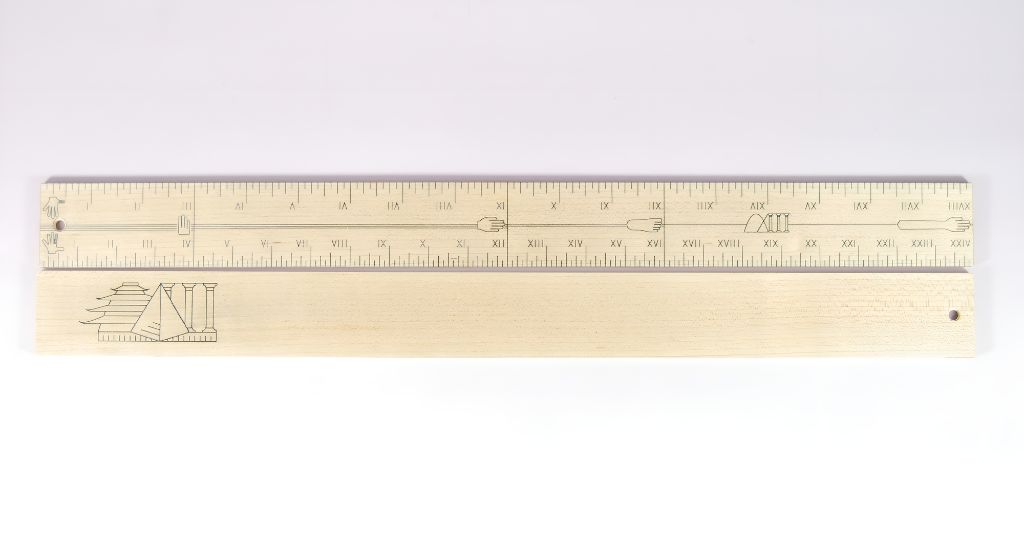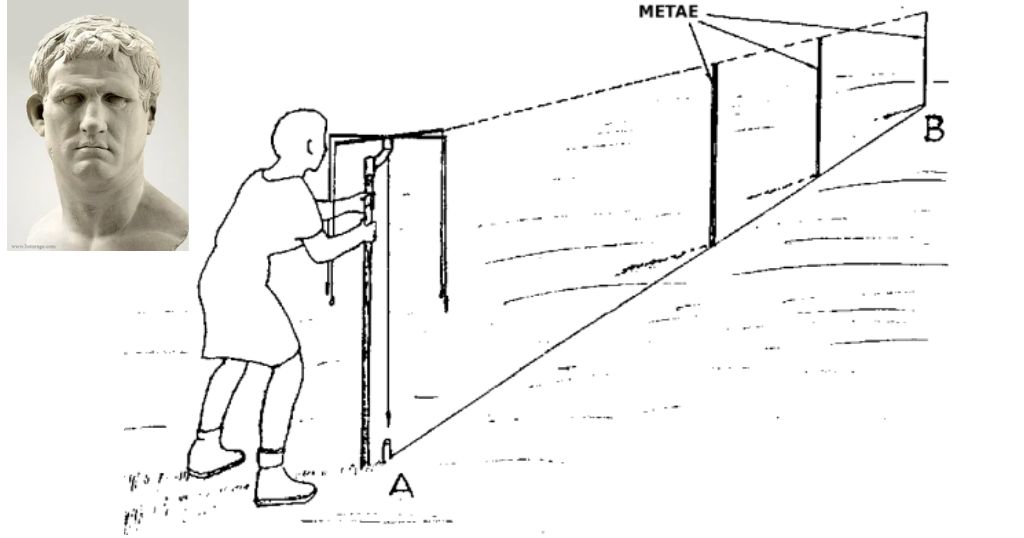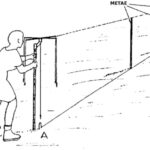Ever wonder how the Romans built structures that still stand today? Or managed trade across their huge empire? The secret was in their measuring systems!
The Romans didn’t just conquer lands – they brought order through consistent measurements. From Britain to Egypt, everyone used the same units, making it easier to build, trade, and run an empire.
Let’s dig into the fascinating world of Roman measurements and see how they still impact our lives today!
Archaeological Evidence for Roman Measurements
We know so much about Roman measurement systems thanks to objects dug up over the years. Items like bronze rulers, stone weight standards, and measuring tables give us real proof of what they used.
John Greaves published important findings in 1647 after studying ancient Roman objects. He measured the foot marking on Titus Statilius Aper’s tomb, the statue of Cossutius, and even the distances between stones on the Appian Way.
The volcanic eruption that preserved Pompeii and Herculaneum was actually lucky for historians! These sites revealed measuring tools frozen in time – bronze scales in shops, standard measures in marketplaces, and rulers in workshops.
Roman Length Measurements

The backbone of Roman length units was the pes or Roman foot, measuring about 296 mm (a bit shorter than our modern foot) (Wikipedia). This was the building block for their entire measurement system.
Romans divided their foot two ways – into 16 digiti (fingers) of about 18.5 mm each, or into 12 unciae (inches) of about 24.6 mm. Sound familiar? Our modern inch comes directly from that Roman uncia!
For longer distances, Romans used units like the passus (5 feet, or one double step) and the mille passus (1,000 paces, or about 1.48 km). That “mille passus” is where we get our word “mile” from, though our modern mile is longer.
Roman road builders used a clever device called an odometer to measure long distances. This cart-like invention, described by Vitruvius in De Architectura, had gears connected to wheels that dropped pebbles into a container to count distance traveled.
Roman Area Measurements
For measuring land, which was vital for farming and taxes, Romans based their units on squares of their length measurements. The basic unit was the pes quadratus (square foot).
The most important area unit was the jugerum (about 2,523 square meters), which represented the amount of land a yoke of oxen could plow in one day. This practical approach shows how Romans tied their measurements to everyday work.
Larger farms were measured in units like the heredium (two jugera, meant as a family inheritance) and the centuria (100 heredia, often given to retired soldiers). In Southern Spain, locals used a regional unit called the porca that measured about 473 square meters.
Roman Volume Measurements
Romans had different units for measuring liquids and dry goods, but both systems were based on the sextarius (about 546 ml, similar to a pint). This was defined as 1/48 of a cubic Roman foot.
For liquids, they used units like the tiny ligula (11.4 ml, good for medicine), the congius (3.27 liters, for household use), and the amphora (26.2 liters, for shipping wine and oil). The culeus, their largest unit at 524 liters, was used for large wine shipments.
Dry goods like grain were measured in units like the modius (8.73 liters). This was especially important for the government’s grain handouts to citizens (panem et circenses – “bread and circuses”) and for army rations with the larger modius castrensis (12.93 liters).
Roman Weight Measurements
The main Roman weight unit was the libra (about 328.9 grams), which is where we get our abbreviation “lb.” for pounds today! Romans used a duodecimal system, dividing the libra into 12 unciae (ounces). (Wikipedia)
Smaller weights were crucial for medicine, jewelry making, and coin minting. Units like the tiny siliqua (0.19 grams, about the weight of a carob seed) allowed for very precise measurements when needed.
The connection between weight and money was strong in Roman times. Many weight units shared names with Roman coins because the value of coins was directly tied to their metal weight. The scrupulum (1.14 grams), for instance, was both a weight unit and a gold coin.
Roman Time Measurement
Romans gave us the basics of our modern calendar when Julius Caesar introduced the Julian calendar in 45 BCE. This replaced their earlier, messier system and set up the 365-day year with leap years we still use (with some later tweaks).
The Roman day was different from ours. They split daylight into twelve horae (hours), but these hours changed length with the seasons! Summer daylight hours were longer than winter ones.
Night was divided into four watches, mainly for military purposes. For more precise time, they had units called minuta (1/60 of a day), secunda (1/3600 of a day), and tertia (1/216,000 of a day) – the roots of our minutes and seconds!
Don’t forget to Bookmark PunsCraft for measurement related information.
Measurement Tools and Devices of Romans

Romans had some impressive tools for their time. Surveyors used the groma, a cross-shaped device for making straight lines and right angles when mapping out cities or roads.
For weighing things, they had two main types of scales: simple pan balances for light items and the statera (steelyard) with sliding weights for heavier goods. Many beautiful examples of these bronze scales survive in museums today.
The Roman odometer was a true marvel of ancient engineering. It counted wheel rotations on a cart to measure distance traveled, with gears that dropped pebbles to mark each mile. This invention, possibly based on ideas from Archimedes, helped map the vast empire accurately.
Standardization and Administration
What made Roman measurements special was their consistency across the whole empire. A foot in Rome was the same as a foot in distant Britain or Egypt, making trade and building much easier.
Officials called aediles checked marketplace weights and measures, and bronze standards were placed in public squares for everyone to reference. These officials made sure no one was using false measures to cheat customers.
Archaeological finds show how important standard measures were to the government. A bronze modius from the 4th century AD has an inscription showing imperial approval, proving that Roman authorities actively regulated measurements throughout their territories.
Practical Applications
Roman measurements weren’t just theoretical – they were used daily in all aspects of life. The military used standard measures for camp layouts, equipment specs, and food rations.
In markets, standard measures ensured fair trade practices. Excavations in Pompeii revealed market counters with built-in measure standards so customers could check they weren’t being cheated.
Architects and builders relied completely on these measurements. Roman structures like aqueducts needed precise measurements to work properly – water flowing through pipes was carefully calculated based on standardized pipe diameters called the quinaria system.
Regional Variations and Adaptations
Though Romans pushed for standardized measurements, they were also practical. In some areas, they allowed local units to continue alongside official Roman ones.
In Germania Inferior (parts of modern Netherlands, Belgium, and Germany), people used the pes Drusianus – about 333 mm, longer than the standard Roman foot of 296 mm.
Columella, writing in his farming guide De Re Rustica, mentions regional land units like the Gallic cadetum, showing how Romans sometimes adapted to local customs rather than forcing change.
Romans Mathematical Relationships
Romans created a smart system where measurements related to each other mathematically. For example, their standard amphora held exactly 80 librae of water, connecting volume directly to weight.
The uncial system (dividing into twelfths) made it easier to calculate fractions in a time before decimal points existed. This system was used for weights, length, and even inheritance shares.
Land measurements were designed for easy calculation – a jugerum was exactly 28,800 square feet (240 × 120 feet), allowing simple multiplication for field areas without needing complex math.
Legacy and Influence of Romans in Measurements
Many of our modern measurements come straight from Roman ones. The mile, pound (lb.), inch, and ounce all have direct Roman measurement ancestors.
Even after the empire fell, Roman units lived on through medieval Europe, gradually evolving into the Imperial system still used in the US and a few other countries today.
When we organize things by dozens or divide hours into 60 minutes, we’re following patterns set up by Romans and their number systems. Their practical approach to measurement shaped how we organize our world.
Digital Reconstruction of Roman Measurement Tools
Modern technology has helped us better understand Roman tools. Computer models have recreated how the odometer and groma actually worked in practice.
3D scanning of surviving measuring artifacts has let researchers determine exact values of standard units to fractions of a millimeter, much more precisely than ever before.
Archaeological sites can now be mapped using GPS and laser scanning, revealing the exact implementations of Roman measurements in city layouts and field divisions that are still visible in some landscapes today.
Comprehensive Reference Tables
Here’s a quick look at the main Roman length units and their modern values:
| Roman Unit | Meaning | Modern Equivalent |
| digitus | finger | 18.5 mm |
| uncia | inch/thumb | 24.6 mm |
| palmus | palm | 74 mm |
| pes | foot | 296 mm |
| passus | pace | 1.48 m |
| mille passus | mile | 1.48 km |
For area, the main units were:
| Roman Unit | Modern Equivalent | Common Use |
| pes quadratus | 0.0876 m² | Small areas |
| jugerum | 2,523 m² | Standard farm plot |
| heredium | 5,047 m² | Family farm |
| centuria | 50.5 hectares | Veterans’ land grants |
These tables give you a quick reference to understand the scale Romans worked with, from tiny measurements to empire-spanning distances.
Role of Romans in Water Management and Engineering Measurements

Roman aqueducts and water systems used specialized measurements. Pipe sizes were standardized using the quinaria system, based on pipe diameter in quarter-digits.
Water rights were allocated based on these standard pipe sizes. A quinaria pipe (5/4 digit diameter or about 2.3 cm) delivered a specific water volume, with larger sizes following a standard scale.
According to ancient water commissioner Frontinus, Romans had sophisticated methods for measuring water flow rates based on pipe diameter and pressure. This knowledge let them build water systems that served cities of hundreds of thousands of people.
Conclusion
The Roman measurement system was a remarkable achievement that helped build and maintain one of history’s greatest empires. By creating consistent units for length, area, volume, weight, and time, the Romans made trade, construction, and governance possible across their vast territories.
What made their system special was how practical it was. Units based on the human body or daily work made them intuitive to use, while mathematical relationships between different measurements created a cohesive system.
When we use miles, pounds, or divide things into twelve parts, we’re continuing a measuring tradition started over 2,000 years ago by Roman engineers and administrators. Their legacy lives on in how we measure our world today.
FAQ’s (Frequently Asked Questions)
Why did Romans use a base-12 system for many measurements?
Romans liked dividing things into twelfths because it’s easy to split into halves, thirds, quarters, and sixths without fractions. This made everyday calculations much simpler in a world without calculators.
How accurate were Roman measurements compared to modern ones?
Pretty impressive! Roman aqueducts needed slopes of just the right angle to work properly, sometimes maintaining a precise grade over many miles. Studies of surviving structures show they achieved remarkable precision.
Did Romans use different measurements for trade versus construction?
Yes and no. The same basic units were used, but specialized professions had their own custom units. Architects used modules based on column diameters, while doctors had tiny specialized weight units for medicines.
How do we know what Roman units actually measured in modern terms?
Archaeological evidence gives us the answers. Researchers like John Greaves measured surviving artifacts, buildings, and distance markers. Modern techniques like 3D scanning have made these measurements even more precise.
Did Romans have something like the metric system?
Not exactly, but their system was more standardized than most ancient ones. Unlike the metric system’s base-10 approach, Romans preferred working with base-12 and base-16 divisions for many measurements.
Disclaimer:
This article is intended for informational and educational purposes only. While every effort has been made to ensure the accuracy of historical data and measurement conversions, interpretations may vary based on new archaeological findings or scholarly research. The information provided here is based on historical records, expert analysis, and modern reconstructions of Roman systems. For academic or professional use, please consult original sources and peer-reviewed materials.

Hi there! I’m Jack, the writer of Punscraft.com. I’ve been writing and breaking down real-world measurements for over 7 years and I still love helping people see the size behind the numbers.
On Punscraft, we make inches, feet, and centimeters easy to understand by comparing them to everyday objects you already know. Whether you’re trying to picture how big 20 inches is or what’s actually 100 feet long, I’ve got you covered with fun, simple, and visual guides.
I like to keep things clear, relatable, and packed with useful facts like conversation with a companion who’s good with a tape measure.
If you’ve ever wondered “How big is that really?”, then you’re in the right place.
Thanks for stopping by Punscraft.com. Let’s make measuring make sense together!



